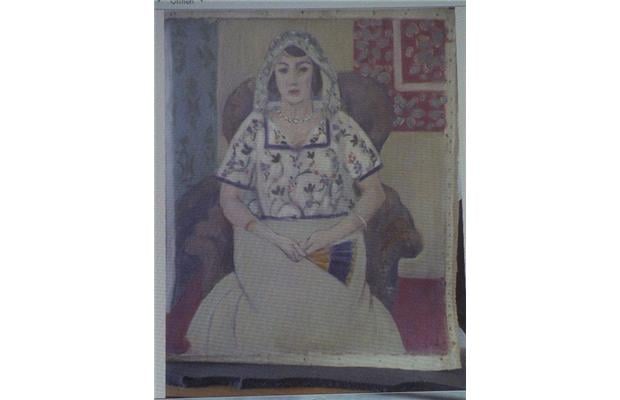Quite by coincidence, two stories we have covered in the last few days have centered around the claims by the heirs of Paul von Mendelssohn Bartholdy, a Jewish banker and art collector who was the target of Nazi persecution before he died in 1935: Julius Schoeps, Edelgard von Lavergne-Peguilhen, and Florence Kesselstatt. Another common thread has been the Bavarian State Paintings Collection (the Bayerische Staatsgemäldesammlung), which is in the news again for possible claims, but this time from heirs of quite a different sort.
Nicholas O'Donnell

Recent Posts
Bavarian State Paintings Collection in the News Again, May Face Claims from Eva Braun Heirs
Topics: Paul von Mendelssohn Bartholdy, Fritz Bamberger, Focus, Florence Kesselstatt, Karl Blechen, Karl Ernst Baumann, Julius Schoeps, Dr Alexander Lewin, Germany, Anselm Feuerbach, Hans Sachs, German Advisory Commission for the Return of Cultu, Gurlitt case, Edelgard von Lavergne-Peguilhen, Julius and Clara Freund, Eva Braun, Nürnberger Institut, Johann J. August von der Embde, Stiftung Preussischer Kulturbesitz, 'Stürmer-Bibliothek', Wilhelm Leibl, Jim Tobias, Portrait der Familie von Dithfurth, Restitution, Bavarian State Paintings Collection, Bayerische Staatsgemäldesammlung, Der Spiegel, World War II, Peasant Girl without a Hat and with a White Headcl, Pinakothek der Moderne, Prussian Cultural Heritage Foundation, Austria, Andrea Bambi Mountain Landscape on the Spanish Coa, Jutta Limbach, Washington Principles, Der Stürmer, Welfenschatz, Limbach Commission
Claims by Mendelssohn Bartholdy Heirs over Picasso "Madame Soler" Dismissed, Court Finds No FSIA Jurisdiction After Evidentiary Hearings
The U.S. District Court for the Southern District of New York has dismissed claims for ownership of Madame Soler by Pablo Picasso, currently at the Pinakothek der Moderne in Munich. Just as the relevance of Judge Jed Rakoff’s comments over another art restitution case brought by the heirs of Paul von Mendelssohn Bartholdy unexpectedly came to the fore recently, Judge Rakoff’s decision is now the most recent in a line of frustrations for the heirs of Mendelssohn Bartholdy, a victim of Nazi persecution in Berlin in the 1930s. The ramifications of this case may be fairly narrow, however, as the case was premised on allegations of specific transactions in New York rather than general allegations about the conduct of Germany. The claimants could appeal, or perhaps turn to the Limbach Commission if they could be heard (the Pinakothek is a subdivision of Germany for jurisdictional analysis, but it’s unclear at first blush if the Commission would view this claim as within its province).
Topics: Paul von Mendelssohn Bartholdy, Berlin, commercial activity exception, Cornelius Gurlitt, Florence Kesselstatt, Judge Jed Rakoff, Halldor Soehner, Saint-Jean-Cap-Ferrat, Julius Schoeps, Upper East Side, Prussia, Max Liebermann, Night Café, Gurlitt Collection, Foreign Sovereign Immunities Act, Preussen, France, State Paintings Collection, Madame Soler, Museum of Modern Art, Edelgard von Lavergne-Peguilhen, Van Gogh, Munich, Justin K. Thannhauser, FSIA, expropriation exception”, Nazi persecution, Boy Leading a Horse, Restitution, David Toren, Bayerische Staatsgemäldesammlung, Bavarian State Ministry for Education and Culture, Free State of Bavaria, World War II, Foreign Sovereign Immunities, Pinakothek der Moderne, Bayerisches Staatsministerium für Bildung und Kult, Bundesländer, Altmann v. Republic of Austria, Freistaat Bayern, Le Moulin de la Galette, Kurt Martin, München, Pablo Picasso, Federal Republic of Germany, Limbach Commission, Wissenschaft und Kunst
Analysis and Views Develop on New York Art Authentication Protection Bill
As we reported back in February, the State Assembly and Senate are considering parallel versions of an amendment to the New York Arts & Cultural Affairs Law that would enhance protections for art authenticators by raising the burden of proof and providing for prevailing-party attorneys’ fees. Our view was, and remains, that the law would be an improvement on the status quo because it would protect the player that often has the least upside in an authentication but who may find herself the target of the disappointed party’s wrath.
Topics: Donn Zaretsky, Andy Warhol Foundation, Art in America, Daniel Grant, New York State Assembly, authentication, Tracy Zwick, American Rule, Bill No. A09016, Art Law Day, New York Observer, clear and convincing evidence, Wolfgang Beltracchi, Art Law Committee, Chagall Committee, Appraisers Association of America, Keith Haring Foundation, New York Arts and Cultural Affairs Law, New York City Bar Association, authenticator, M. Knoedler & Co., Chagall, Senate Bill No. S06794
St. Louis Art Museum Dismisses Its Lawsuit Over Mask of Ka-Nefer-Nefer, Could Bring it Again if It Chose
I wondered aloud two weeks ago what the St. Louis Art Museum would do with its declaratory judgment action over the Mask of Ka-Nefer-Nefer after the U.S. Court of Appeals for the 8th Circuit affirmed the dismissal of the related forfeiture action brought by the government. With the question of seizure answered for good, I suggested that the museum’s next move might be to dismiss its first-filed lawsuit, because its incentive to litigate the question of title was effectively removed entirely with the forfeiture off the table. Judith H. Dobrzynski picked up on this theme at Real Clear Arts.
Topics: Mask of Ka-Nefer-Nefer, Real Clear Arts, St. Louis Art Museum, Department of Justice, Judith H. Dobrzynski, Fed. R. Civ. P. 59(e), 19 U.S.C. § 1595a, United States, Federal Rules of Civil Procedure, Customs, Civil Forfeiture, Ancient Egypt
"Fight Over Paintings Looted by Nazis May Finally Get Trial Thanks to 9th Cir." Published by Bloomberg BNA
I am quoted at length in an article about the recent Von Saher decision: "Fight Over Paintings Looted by Nazis May Finally Get Trial Thanks to 9th Cir." by Nicholas Datlowe, published by Bloomberg BNA’s United States Law Week. The article covers the overall background and importance of the decision, and has quotes from the plaintiffs’ attorneys who now can return to the trial court to try to press their claim (and respond to the likely forthcoming act of state defenses, as discussed here previously). It also analyzes the dissent in the June 6, 2014 opinion by Judge Kim McLane Wardlaw, who would have upheld the trial court dismissal under the foreign affairs doctrine. 
Topics: Bloomberg BNA, 82 U.S.L.W. 1944, Dutch Secretary for Education Culture and Science, Norton Simon Museum, Alois Miedl, Lilly Cassirer, Norton Simon Art Foundation, Rue Saint-Honoré après-midi effet de pluie, Jacques Goudstikker, Howard N. Spiegler, Fred Anthony Rowley, George Stroganoff-Scherbatoff, Hermann Goring, Harry Pregerson, Restitution, Marei Von Saher, Jr., World War II, act of state doctrine, Cassirer v. Kingdom of Spain, United States Law Week, Lucas Cranach the Elder, Camille Pissarro, Dorothy Wright Nelson, http://www.bna.com., The Bureau of National Affairs Inc., Kim McLane Wardlaw, Soviet Union, foreign affairs doctrine, California Section 354.3 of Code of Civil Procedur, Von Saher v. Norton Simon Museum of Art
What Happens to St. Louis Art Museum Suit Against the U.S. over the Mask of Ka Nefer Nefer—Will Museum Dismiss its Case Voluntarily?
On the heels of the St. Louis Art Museum’s victory against the civil forfeiture action over the Mask of Ka-Nefer-Nefer, the question arises what the museum will do with the lawsuit it filed in 2011 concerning the mask. That lawsuit, The Art Museum Subdistrict of the Metropolitan Zoological Park and Museum District of the City of Saint Louis and the County of Saint Louis, (the “SLAM Case”) filed before the civil forfeiture action that was the subject of last week’s opinion(United States vs. Mask of Ka-Nefer-Nefer, hereafter the “Forfeiture Action”), sought a declaratory judgment on several issues. This tactic is not uncommon when two parties disagree over a claim; essentially the party who would ordinarily be the defendant (here the possessor of the property, the museum), seeks offensively a declaration about the parties’ rights. Because of its recent victory in the Forfeiture Action, the museum’s best move may be to dismiss the SLAM Case now, rather than litigate ownership questions that it no longer has to answer.
Topics: Mask of Ka-Nefer-Nefer, Mohamed Ibrahim, St. Louis Art Museum, Department of Justice, Fed. R. Civ. P. 59(e), the Art Law Report, 19 U.S.C. § 1595a, United States, Federal Rules of Civil Procedure, Customs, Minister of Antiquities, Civil Forfeiture, Ancient Egypt
Appeals Court Rules Mask of Ka-Nefer-Nefer Will Stay at St. Louis Art Museum Because Government Missed Deadlines
The Court of Appeals for the 8th Circuit has affirmed the dismissal of the U.S. government’s attempt to seize the Mask of Ka-Nefer-Nefer from the St. Louis Art Museum. Despite the government’s persistent characterization the mask as stolen before it entered the country, the civil forfeiture case has been rebuffed. The narrow issue was whether the trial court had properly denied the government’s request to amend its complaint after an initial challenge, but as the 8th Circuit put it, “Underlying that issue is an attempt to expand the government’s forfeiture powers at the likely expense of museums and other good faith purchasers in the international marketplace for ancient artifacts.” That latter question will have to wait another day, because the case was resolved on the government’s missed deadlines and nothing more.
Topics: Mask of Ka-Nefer-Nefer, St. Louis Art Museum, Department of Justice, Fed. R. Civ. P. 59(e), the Art Law Report, Restitution, 19 U.S.C. § 1595a, United States, Antiquities, Federal Rules of Civil Procedure, Customs, Civil Forfeiture, Ancient Egypt
Gurlitt Task Force Makes First Determination that Matisse "Seated Woman" Was Stolen From Rosenbergs; Questions Remain About What Happens Next
The Gurlitt Task Force has issued its first public conclusion about the status of work amongst the collection found in Cornelius Gurlitt's apartment. Chair Ingebeborg Berggreen-Merkel issued a statement today that (my translation):
Topics: Schwabinger Kunstfund, Hildebrand Gurlitt, Cornelius Gurlitt, Gurlitt Task Force, Nazi-looted art, Gurlitt Collection, Entartete Kunst, Munich art trove, Anne Sinclair, NS Raubkunst, Restitution, World War II, Kunstmuseum Bern, Washington Principles, Sitzende Frau, Kunstfund München, Henri Matisse, Paul Rosenberg
Restitution Claims for Cranach Paintings in the Norton Simon Museum Revived by Ninth Circuit, Case Now Hinges on Act of State Doctrine
The U.S. Court of Appeals for the Ninth Circuit restored on June 6, 2014 the claims by Marei von Saher against the Norton Simon Museum in Pasadena for the paintings Adam and Eve by Lucas Cranach the Elder. The appeals court followed its decision in Cassirer v. Kingdom of Spain in December of last year, concerning the painting Rue Saint-Honoré, après-midi, effet de pluie by Camille Pissarro that was owned at one time by Lilly Cassirer, a Jewish collector who fled Germany in 1939. While the panel of judges vacated the Von Saher dismissal that was premised on the idea that California’s revised statute of limitations was unconstitutional (instead finding that the law and claims withstand that scrutiny), the divided 2-1 panel sent the case back to the district court to determine if the claims were nonetheless barred under the “act of state doctrine”. One dissenting judge would have upheld the dismissal on the grounds that the case would call into question Von Saher’s compensation from the Dutch government such that that would violate the foreign affairs doctrine. That split on the act of state doctrine partially answers the lingering question of why Von Saher, argued the same day as Cassirer concerning the same California law, had gone undecided six months after Cassirer was resolved.
Topics: Dutch Secretary for Education Culture and Science, Norton Simon Museum, Alois Miedl, Lilly Cassirer, Norton Simon Art Foundation, Rue Saint-Honoré après-midi effet de pluie, Jacques Goudstikker, Howard N. Spiegler, Fred Anthony Rowley, George Stroganoff-Scherbatoff, Hermann Goring, Harry Pregerson, Restitution, Marei Von Saher, Jr., World War II, Foreign Sovereign Immunities, act of state doctrine, Cassirer v. Kingdom of Spain, Lucas Cranach the Elder, Camille Pissarro, Dorothy Wright Nelson, http://www.bna.com., Kim McLane Wardlaw, Soviet Union, foreign affairs doctrine, California Section 354.3 of Code of Civil Procedur, Von Saher v. Norton Simon Museum of Art
A Trust For The Benefit of the Public is Not “the Public Trust”—The Deaccessioning Debate and the Detroit Institute of Arts
Reflecting on the recent argument by the Detroit Institute of Arts that the city of Detroit cannot legally sell, let alone be forced to sell, the artwork in the museum to satisfy creditor, some overlapping terminology creates the possibility of an important confusion. Particularly in the realm of deaccessioning, this distinctions are quite important. Meanwhile, the state of Michigan today approved its part of the “Grand Bargain” to subsidize the bankruptcy to avoid sale or encumbrance of the artwork.
Topics: Donn Zaretsky, Roberta Smith, Rose Art Museum, Lee Rosenbaum, Columbia University, Deaccessioning, Detroit Institute of Arts, Isabella Stewart Gardner Museum, Association of Art Museum Directors, Michigan, Albright-Knox Gallery, New York Times, Detroit Bankruptcy, AAMD, Edward Hopper, Pennsylvania Academy of Fine Arts, grand bargain, Brandeis University, Barnes Foundation






